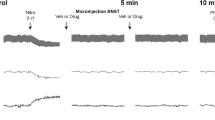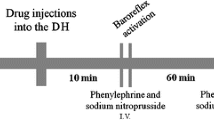Abstract
The involvement of glutamatergic neurotransmission in the rostral ventrolateral medulla (RVLM) in the suppression of baroreflex bradycardia by the parabrachial nucleus (PBN) was investigated. Repeated electrical activation of the PBN increased the concentration of glutamate in the dialysate collected from the RVLM. The same stimulation also suppressed baroreflex bradycardia in response to transient hypertension evoked by phenylephrine (5 µg/kg, intravenously). Microinfusion ofL-glutamate (10, 50 or 100 µM) via the microdialysis probe into the RVLM dose-dependently elicited a significant inhibition of baroreflex bradycardia that paralleled the concentration and time course of the PBN-elicited elevation in extracellular glutamate in the RVLM. The suppression of baroreflex bradycardia elicited by microinjection ofL-glutamate (1 nmol) into the RVLM was appreciably reversed by coinjection of the NMDA receptor antagonist, dizocilpine (500 pmol), or the non-NMDA receptor antagonist, 6-cyano-7-nitroquinoxaline-2,3-dione (50 pmol). These results suggest that an increase in the extracellular concentration of glutamate and activation of both NMDA and non-NMDA receptors in the RVLM may mediate the suppression of baroreflex bradycardia by activation of the PBN.
Similar content being viewed by others
References
Barnard EA. Ionotropic glutamate receptors: New types and new concepts. Trends Pharmacol Sci 18:141–148;1997.
Caringi D, Maher TJ, Chaiyakul P, Asmundsson G, Ishide T, Ally A. Extracellular glutamate increases in rostral ventrolateral medulla during static muscle contraction. Pflügers Arch 435:465–471;1998.
Chamberlin NL, Saper CB. Topographic organization of cardiovascular responses to electrical and glutamate microstimulation of the parabrachial nucleus in the rat. J Comp Neurol 326:245–262;1992.
Chan JYH, Yang SM, Chan SHH. Mediation byN-methyl-D-aspartate and non-N-methyl-D-aspartate receptors in the expression of Fos protein at the nucleus tractus solitarii in response to baroreceptor activation in the rat. Neuroscience 83:93–105;1998.
Chan JYH, Tsou MY, Len WB, Lee TY, Chan SHH. Participation of noradrenergic neurotransmission in the enhancement of baroreceptor reflex response by substance P at the nucleus tractus solitarii of the rat: A reverse microdialysis study. J Neurochem 64:2644–2652;1995.
Chan SHH, Chan JYH. Application of reverse microdialysis in the evaluation of neural regulation of cardiovascular functions. Anal Chim Acta 379:275–279;1999.
Ciriello J. Brainstem projections of aortic baroreceptor afferent fibers in the rat. Neurosci Lett 36:37–42;1983.
Danbolt NC, Storm-Mathisen J, Ottersen OP. Sodium/potassium-coupled glutamate transporters, a ‘new’ family of eukaryotic proteins: Do they have ‘new’ physiological roles and could they be new targets for pharmacological intervention? Prog Brain Res 100:53–60;1994.
Dawson LA, Stow JM, Palmer AM. Improved method for the measurement of glutamate and aspartate using capillary electrophoresis with laser-induced fluorescence detection and its application to brain microdialysis. J Chromatogr B Biomed Sci Appl 694:455–460;1997.
Fink GD, Pawloski CM, Ohman LE, Haywood JR. Lateral parabrachial nucleus and angiotensin II-induced hypertension. Hypertension 17:1177–1184;1991.
Fulwiler CE, Saper CB. Subnuclear organization of the efferent connections of the parabrachial nucleus in the rat. Brain Res 319:229–259;1984.
Gegelashivili G, Schousboe A. Cellular distribution and kinetic properties of high-affinity glutamate transporter. Brain Res Bull 45:233–238;1998.
Guyenet PG. Role of the ventral lateral medulla oblongata in blood pressure regulation. In: Leowy AD, Spyer KM, eds. Central Regulation of Autonomic Functions. New York, Oxford University Press 145–167;1990.
Hand GA, Potts JT, Treuhaft BS, Wilson LB, Petty F, Mitchell JH. Static muscle contraction elicits a baroreflex-dependent increase in glutamate concentration in the ventrolateral medulla. Brain Res 748:211–218;1997.
Herbert H, Moga MM, Saper CB. Connections of the parabrachial nucleus with the nucleus of the solitary tract and medullary reticular formation in the rat. J Comp Neurol 293:540–580;1990.
Honore T, Davies SN, Drejer J, Fletcher EJ, Jacobsen P, Lodge D, Nielssen FE. Quinoxalinediones: Potent competitive non-N-methyl-D-aspartate glutamate receptor antagonists. Science 241:701–703;1988.
Hubbard JW, Buchholz RA, Keeton TK, Nathan MA. Parabrachial lesions increase plasma norepinephrine concentration, plasma renin ativity and enhance baroreflex sensitivity in the conscious rat. Brain Res 421:226–234;1987.
Jhamandas JH, Harris KH. Excitatory amino acids may mediate nucleus tractus solitarius input to rat parabrachial neurons. Am J Physiol 263:R324-R330;1992.
Jones BN, Gilligan JP.o-Phthaldialdehyde precolumn derivatization and reversed-phase high-performance liquid chromatography of polypeptide hydrolysates and physiological fluids. J Chromatogr 266:471–482;1983.
Kemp JA, Prestley T, Woodruff GN, MK-801: A novel, orally active anticonvulsant, is a potent, non-competitiveN-methyl-D-aspartate antagonist. Br J Pharmacol 89:535P;1986.
Kihara M, Misu Y, Kube T. Release by electrical stimulation of endogenous glutamate, γ-aminobutyric acid, and other amino acids from slices of the rat medulla oblongata. J Neurochem 52:261–267;1989.
Kobayashi T, Caringi D, Mokler DJ, Ally A. Effects of ventrolateral medullary AMPA-receptor antagonism on pressor response during muscle contraction. Am J Physiol 272:H2774-H2781;1997.
Kodama T, Lai YY, Siegel JM. Enhanced glutamate release during REM sleep in the rostromedial medulla as measured by in vivo microdialysis. Brain Res 780:178–181;1998.
Kubo T, Kihara M, Misu Y. Altered amino acid levels in brainstem regions of spontaneously hypertensive rats. Clin Exp Hypertens A 11:233–241;1989.
Kubo T, Nagura J, Kihara M, Misu Y. Cardiovascular effects ofL-glutamate and γ-aminobutyric acid injected into the rostral ventrolateral medulla in normotensive and spontaneously hypertensive rats. Arch Int Pharmacodyn Ther 279:150–161;1986.
Lara JP, Parkes MJ, Silva-Carvhalo L, Izzo P, Dawid-Milner MS, Spyer KM. Cardiovascular and respiratory effects of stimulation of cell bodies of the parabrachial nuclei in the anaesthetised rat. J Physiol (Lond) 477:321–329;1994.
Len WB, Chan JYH. Glutamatergic projection to RVLM mediates suppression of reflex bradycardia by parabrachial nucleus. Am J Physiol 276:H1482-H1492;1999.
Len WB, Tsou MY, Chan SHH, Chan JYH. Participation of presynaptic noradrenergic fibers in the suppression of α2-adrenoceptor activity by substance P at the nucleus reticularis gigantocellularis of the rat. Synapse 21:357–363;1995.
Livingston CA, Berger AJ. Immunocytochemical localization of GABA in neurons projecting to the ventrolateral nucleus of the solitary tract. Brain Res 494:143–150;1989.
Mao L, Abdel-Rahman AA. Inhibition of glutamate uptake in the rostral ventrolateral medulla enhances baroreflex-mediated bradycardia in conscious rats. Brain Res 654:343–348;1994.
Menacherry S, Hubert W, Justice JB Jr. In vivo calibration of microdialysis probes for exogenous compound. Anal Chem 64:577–583;1992.
Miele M, Berners M, Boutelle MG, Kusakabe H, Fillenz M. The determination of the extracellular concentration of brain glutamate using quantitative microdialysis. Brain Res 707:131–133;1996.
Miele M, Boutelle MG, Fillenz M. The source of physiologically stimulated glutamate efflux from the striatum of conscious rats. J Physiol (Lond) 497:745–751;1996.
Morari M, O'Conner WT, Ungerstedt U, Fuxe K.N-methyl-D-aspartic acid differentially regulates extracellular dopamine, GABA, and glutamate levels in the dorsolateral neostriatum of the halothane-anesthetized rat: An in vivo microdialysis study. J Neurochem 60:1884–1893;1993.
Mortensen LH, Ohman LE, Haywood JR. Effects of lateral parabrachial nucleus lesions in chronic renal hypertensive rats. Hypertension 23:774–780;1994.
Paleckova V, Palecek J, McAdoo DJ, Willis WD. The non-NMDA antagonist CNQX prevents release of amino acids into the rat spinal cord dorsal horn evoked by sciatic nerve stimulation. Neurosci Lett 148:19–22;1992.
Saleh TM, Connell BJ. Modulation of the cardiac baroreflex following reversible blockade of the parabrachial nucleus in the rat. Brain Res 767:201–207;1997.
Saleh TM, Bauce LG, Pittman QJ. Glutamate release in parabrachial nucleus and baroreflex alterations after vagal afferent activation. Am J Physiol 272:R1631-R1640;1997.
Spyer KM. Central nervous mechanisms contributing to cardiovascular control. J Physiol (Lond) 474:1–19;1994.
Takayama K, Miura M. Difference in distribution of glutamate-immunoreactive neurons projecting into the subretrofacial nucleus in the rostral ventrolateral medulla of SHR and WKY: A double-labeling study. Brain Res 570:259–266;1992.
Timmerman W, Westerink BHC. Brain microdialysis of GABA and glutamate: What does it signify? Synapse 27:242–261;1997.
Tsou MY, Len WB, Chang AYW, Chan JYH, Lee TY, Chan SHH. Characterization and application of microdialysis probes with an active exchange length compatible with small-size brain nuclei in the rat. Neurosci Lett 175:137–140;1994.
Tsou MY, Len WB, Lee TY, Chan SHH, Pan WHT, Chan JYH. Participation of noradrenergic neurotransmission in the suppression by substance P of α2-adrenoceptors at the nucleus reticularis gigantocellularis involved in central cardiovascular regulation in the rat. Brain Res 653:183–190;1994.
Tsuchihashi T, Averill DB. Metabotropic glutamate receptors in the ventrolateral medulla of rats. Hypertension 21:739–744;1993.
Tsuchihashi T, Kagiyama S, Ohya Y, Abe I, Fujishima M. Antihypertensive treatment and the responsiveness to glutamate in ventrolateral medulla. Hypertension 31:73–76;1998.
Wang Q, Li P. Stimulation of ventrolateral medulla inhibitis the baroreceptor input to the nucleus tractus solitarius. Brain Res 473:227–235;1988.
Yang CCH, Kuo TBJ, Chan SHH. Auto- and cross-spectral analysis of cardiovascular fluctuations during pentobarbital anesthesia in the rat. Am J Physiol 270:H575-H582;1996.
Zhang X, Abdel-Rahman AA, Wooles WR. Selective sensitization byL-glutamate of baroreflex-mediated bradycardia following microinjection into the rostral ventrolateral medulla. Brain Res 520:141–150;1990.
Zhu DN, Moriguchi A, Mikami H, Higaki J, Ogihara T. Central amino acids mediate cardiovascular response to angiotensin II in the rat. Brain Res Bull 45:189–197;1998.
Author information
Authors and Affiliations
Rights and permissions
About this article
Cite this article
Len, WB., Chan, S.H.H. & Chan, J.Y.H. Parabrachial nucleus induces suppression of baroreflex bradycardia by the release of glutamate in the rostral ventrolateral medulla of the rat. J Biomed Sci 7, 401–411 (2000). https://doi.org/10.1007/BF02255815
Received:
Accepted:
Issue Date:
DOI: https://doi.org/10.1007/BF02255815




